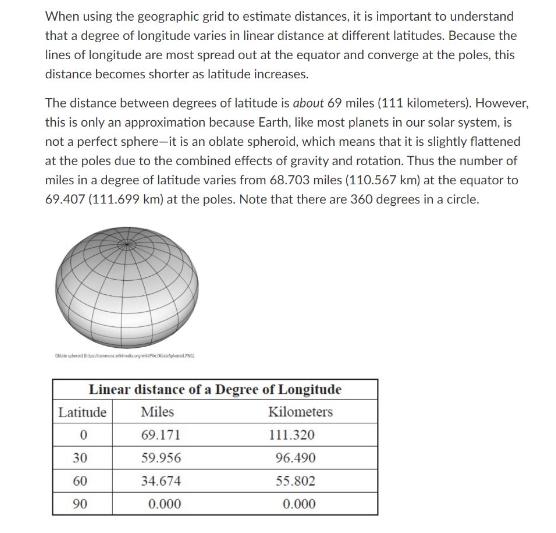Answered step by step
Verified Expert Solution
Question
1 Approved Answer
When using the geographic grid to estimate distances, it is important to understand that a degree of longitude varies in linear distance at different


When using the geographic grid to estimate distances, it is important to understand that a degree of longitude varies in linear distance at different latitudes. Because the lines of longitude are most spread out at the equator and converge at the poles, this distance becomes shorter as latitude increases. The distance between degrees of latitude is about 69 miles (111 kilometers). However, this is only an approximation because Earth, like most planets in our solar system, is not a perfect sphere-it is an oblate spheroid, which means that it is slightly flattened at the poles due to the combined effects of gravity and rotation. Thus the number of miles in a degree of latitude varies from 68.703 miles (110.567 km) at the equator to 69.407 (111.699 km) at the poles. Note that there are 360 degrees in a circle. Linear distance of a Degree of Longitude Latitude Miles Kilometers 0 69.171 111.320 30 59.956 96.490 60 34.674 55.802 90 90 0.000 0.000 Based on the above table, answer questions 1-3: 1. How does the distance between meridians change as you travel from the equator to the poles? 2. What is the distance around the Earth at the equator? Express your answer in miles and in kilometers. 3. What is the distance around the Earth at 60 S? Express your answer in miles and in kilometers? 4. If you wanted to fly west or east around the world (along the same line of latitude for your entire trip), starting and ending at the Prime Meridian, would it be fastest to fly along the 30 N parallel or the 60 N parallel? Explain your reasoning. 5. Ignoring the effect of the oblate spheroid (and assuming the Earth is a perfect sphere), if you were to travel 253 miles north from the equator, how many degrees of latitude would you have covered?
Step by Step Solution
There are 3 Steps involved in it
Step: 1

Get Instant Access to Expert-Tailored Solutions
See step-by-step solutions with expert insights and AI powered tools for academic success
Step: 2

Step: 3

Ace Your Homework with AI
Get the answers you need in no time with our AI-driven, step-by-step assistance
Get Started


